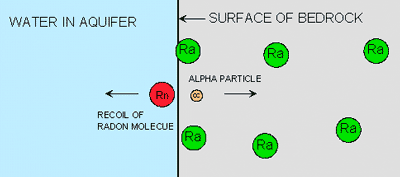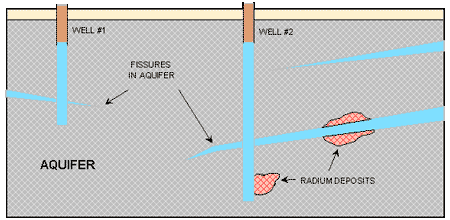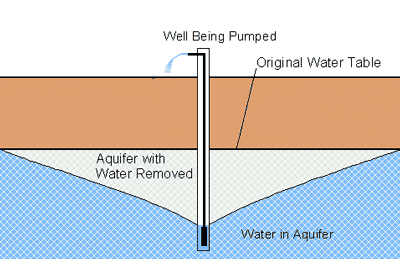Radon Mitigation Systems – Maine Radon Experts
HOW DOES RADON GET INTO YOUR WATER?
 You will have radon in your water if there is radium in the bedrock. The radon is injected into the water in an aquifer by the decay of radium. A radon(Rn) molecule is formed when a radium molecule releases an alpha particle and turns itself into a radon molecule. The radon molecule is recoiled away from the alpha particle that is formed. The recoil causes the radon to be driven into the water.
You will have radon in your water if there is radium in the bedrock. The radon is injected into the water in an aquifer by the decay of radium. A radon(Rn) molecule is formed when a radium molecule releases an alpha particle and turns itself into a radon molecule. The radon molecule is recoiled away from the alpha particle that is formed. The recoil causes the radon to be driven into the water.
The injection of radon into the water will only occur as long as there is a fresh surface of radium next to the water. Radium that decays below the water/rock surface will not release radon into the water. The radium below the surface can only be exposed by erosion. This erosion is usually the result of the action of carbonic acid in the groundwater.
LARGE DIFFERENCES IN RADON CONCENTRATIONS IN WELLS
The radon in your water can be considerably different from the radon in your neighbor’s water (see below). Well #1 would contain very little radon. Well #2 would have a high concentration of radon. Notice, not only does well #2 pass through a fissure with a high concentration of radium, it was actually drilled through a deposit with a high concentration of radium.

BEDROCK WELLS
Aquifers that have a more homogeneous mixture of materials, such as sandstone or sand and gravel, do not typically have either high concentrations of radon or large fluctuation in radon concentrations. This does not mean that the concentration will not be high enough to treat, only that they are unlikely to be as high as those found in igneous bedrock wells.
DAILY FLUCTUATIONS IN WATER RADON
Anytime a well is pumped, the water table will be lowered. The rate of recharge(water moving back into the aquifer) and the rate of pumping from a well will determine the level of the water table.

CONE OF DEPRESSION
As the level of the water changes, the water will be drawn from a different area of the aquifer. If the concentrations of radon are different in these areas of the aquifer, the concentrations of radon in the well water will change.
HOW WATER RADON GETS INTO THE AIR
The radon in your water gets transferred from your water to the air whenever it is exposed to the air. It does not leak through pipes into the air. Some of the activities that cause the release of radon from the water are bathing, cooking and washing. The clothes washer and the shower are the two devices in the home that release the most radon into the air. The factors that affect how much radon will be in the air are the radon concentration, amount of water used, the temperature of the water and the amount of water to air surface area. In an average home, every 10,000 pCi/L of radon in the water will create a 1 pCi/L increase in the air radon. This means, if the radon water concentration is 40,000 pCi/L, the air radon level in your home could be increased by 4 pCi/L because of the water radon.
TESTING FOR RADON IN YOUR WATER
It is suggested by the EPA that if you have elevated air radon levels and are on a private well that you should have your water radon tested. This is good advise for a home owner but not necessarily good advise for a purchaser of a home. The problem in the purchase and testing of a home is that when the air radon is tested there may not be any occupants in the home using water and therefore there will be no contribution to the air radon from the water (see above). In this case (no water usage), the radon levels can be low and the water radon be very high. We have fixed homes where the air radon was high (sometimes as much as 60 pCi/L) and the only reason for this elevated reading was because the radon was being released into the air from the water. If these houses had been tested while there was no water being used, there would not have been enough radon showing up in the test results to suggest further testing.
A home owner can test his own water by buying a test kit from a lab and following the instruction that come with the test kit. If the test is being done for a real estate transaction, by State law the only people that can do the testing is either the home owner or a registered radon service provider. Real estate brokers unless they are registered as a radon service provider can not legally take radon samples. We suggest that you ask your home inspector to do this testing.
REMOVAL OF RADON FROM WATER
There are only two practical techniques for removing radon from water in a residential setting. One technique uses activated carbon. The carbon adsorbs the radon from the water. The radon then finishes decaying in the carbon. Activated carbon should only be used if the radon water levels are below 5000 pCi/L. This low level is recommend by the EPA because of the concern over the build up of radioactivity.
Aeration with a Clearadon is used on very high levels of radon. The radon is released from the water by bubbling air through the water. The radon is then vented to the outdoors. There is no build up of radioactive materials when this technique is used. The removal of well over 99% of the radon from the water can be achieved with these units. These units do require the repressurization of the water after it is treated and care must be taken to properly vent the gas. This venting should be done above the roof line just like an air radon system and there should always be an auxiliary fan outside of the living space to provide for the save removal of the gas.
For more information see the following:
Consumer’s Guide to Radon Reduction , Radon Gas Mitigation , Radon Gas Mitigation Basics , Removal of Radon from Water , Radon and Real Estate Transaction in Maine , Radon in Your Water – from the Experts in Radon Mitigation , What is a Safe Level of Water Radon?
[one_half_last][button link=”http://www.awqinc.com/water-treatment-and-radon-mitigation-library/” newwindow=”yes”]Water Treatment and Radon Mitigation Library[/button][/one_half_last]